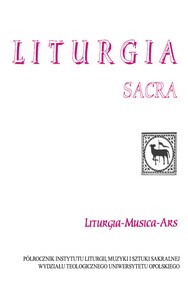Msza h-moll BWV 232 Jana Sebastiana Bacha w świetle estetyki teologicznej Hansa Ursa von Balthasara
Mass in B Minor BWV 232 by Johann Sebastian Bach in Perspective of Hans Urs von Balthasar’s Theological Aesthetics
Author(s): Andrzej Krawiec Subject(s): Christian Theology and Religion, Music, Aesthetics, 18th Century, History of Art
Published by: Uniwersytet Opolski
Keywords: Bach; von Balthasar; aesthetics; philosophy; music; religion; art; theology;
Summary/Abstract: In the first part of his magnum opus Hans Urs von Balthasar presents his project of theological aesthetics where the experience of art becomes an entrance to a religious act and an ennobling way leading to the contemplation of God. Defining the essence of being human as a spiritual being directed towards God bears a deep ethical meaning in this consideration. H.U. von Balthasar’s reflection over the religious dimension of the essence of art is shaped within theology but at the same time in the opposition to aesthetic theology which is described as ‘aesthetisation’ of the Mystery of Revelation. The art of music occupies a particular place in this reflection. For this reason Mass in B Minor BWV 232 by Johann Sebastian Bach, which is an emblematic example of the revelation of the glory of the Lord (Herrlichkeit), will be analysed not only from the perspective of philosophical or musicological aesthetics, but also theological aesthetics. This article outlines characteristic features of theological aesthetics specifically developed from traditional philosophical aesthetics whose range was extended by the human being’s relation to God.
Journal: Liturgia Sacra
- Issue Year: XXVII/2021
- Issue No: 57
- Page Range: 167-194
- Page Count: 28
- Language: Polish

